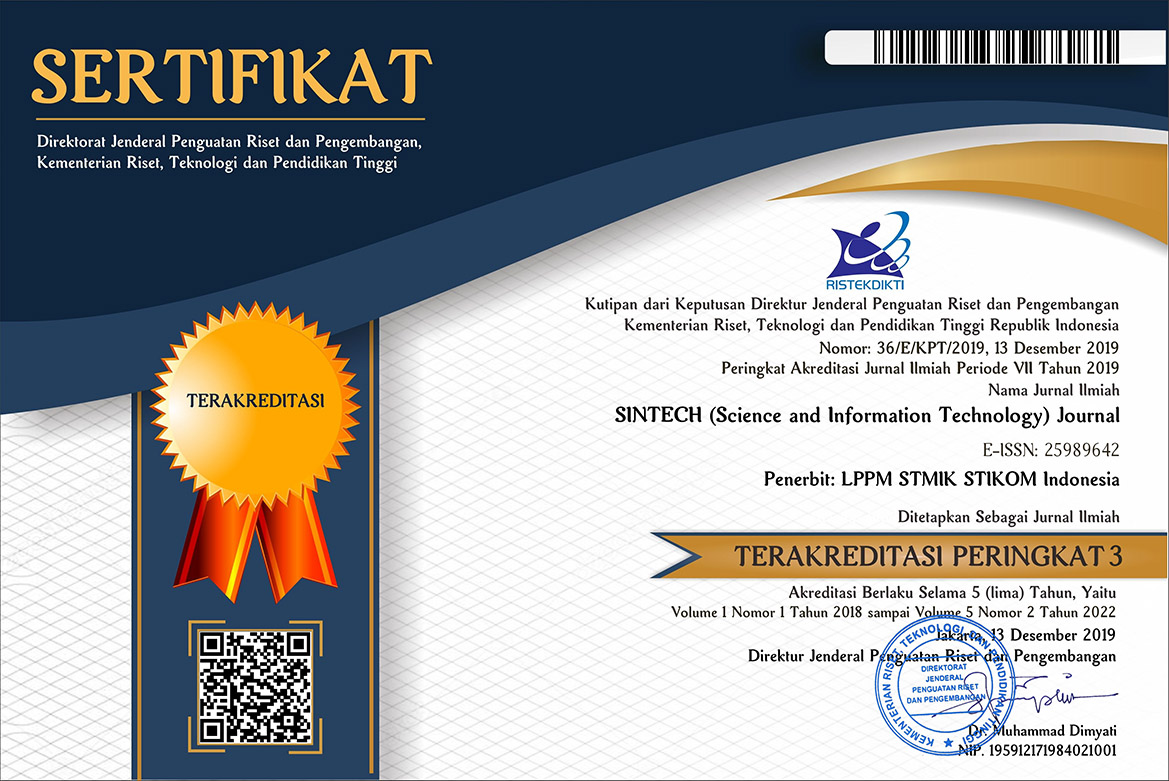Prediksi Jumlah Pasien Covid-19 Dengan Menggunakan Klasifikasi Algoritma Machine Learning
DOI:
https://doi.org/10.31598/sintechjournal.v5i2.1163Keywords:
covid-19, machine learning, classificationAbstract
Corona virus or servere acute respiratory syndrome coronavirus 2 (SARS-CoV-2) is a disease that results in the occurrence of mild to moderate respiratory tract infections. Positive cases of Covid-19 in Indonesia were first detected on March 2, 2020 and continue until 2022. The additional number of deaths caused by COVID-19 has also increased. Therefore, the author is interested in making a predictive model of the cumulative number of COVID-19 patients who died in Indonesia. Therefore, in this study is how to predict the number of patients who die from COVID-19 in Indonesia by creating an appropriate accuracy model to help estimate the number of deaths associated with COVID-19 in Indonesia and assist the government in dealing with cases of new variants of COVID-19. In this study, the authors used the Decision Tree model using entropy criteria as well as Information Gain and Random Forest which resulted in accuracy rates of 91.83% (Decission Tree) and 73.80% (Random Forest). The results, explain that the model used is good. The more the R-squared error value is close to 1, the better the model used will be
Downloads
References
A. Susilo et al., “Coronavirus Disease 2019: Tinjauan Literatur Terkini,” Jurnal Penyakit Dalam Indonesia, vol. 7, no. 1, pp. 45–67, Apr. 2020, doi: 10.7454/JPDI.V7I1.415.
“Infeksi Emerging Kementerian Kesehatan RI,” 2022. https://covid19.kemkes.go.id/dashboard/covid-19 (accessed Sep. 30, 2022).
J. Sindya Widjaya, D. R. Agushinta, and S. Rahayu Puspita Sari, “Sistem Prediksi Jumlah Pasien Covid-19 Menggunakan Metode Trend Least Square Berbasis Web,” Sistemasi: Jurnal Sistem Informasi, vol. 10, no. 1, pp. 39–51, Jan. 2021, doi: 10.32520/STMSI.V10I1.1036.
L. Ainiyah and M. Bansori, “Prediksi Jumlah Kasus COVID-19 menggunakan Metode Autoregressive Integrated Moving Average (ARIMA) (Studi Kasus Kabupaten Sidoarjo),” Jurnal Sains Dasar, vol. 10, no. 2, pp. 62–68, Nov. 2021, doi: 10.21831/JSD.V10I2.43606.
R. A. Indraputra and R. Fitriana, “K-Means Clustering Data COVID-19,” Jurnal Teknik Industri, vol. 10, no. 3, pp. 275–282, Dec. 2020, doi: 10.25105/JTI.V10I3.8428.
R. Ridho and H. Hendra, “Klasifikasi Diagnosis Penyakit Covid-19 Menggunakan Metode Decision Tree,” JUST IT : Jurnal Sistem Informasi, Teknologi Informasi dan Komputer, vol. 11, no. 3, pp. 69–75, Aug. 2022, doi: 10.24853/JUSTIT.11.3.
Kementrian Koordinator Bidang Pembangunan Manusia dan Kebudayaan Republik Indonesia, “Jika Covid 19 Sudah Menjadi Endemi, Penangananya Jadi Seperti Penyakit Biasa,” Jun. 23, 2022. kemenkopmk.go.id/jika-covid-19-sudah-menjadi-endemi-penangananya-jadi-seperti-penyakit-biasa (accessed Oct. 14, 2022).
Dinas Kesehatan Provinsi Kalimantan Barat, “Varian Baru Omicron BA.4 dan BA.5 Terdeteksi di Indonesia, Berbahayakah?,” Jun. 30, 2022. https://dinkes.kalbarprov.go.id/varian-baru-omicron-ba-4-dan-ba-5-terdeteksi-di-indonesia-berbahayakah/ (accessed Oct. 13, 2022).
Linda Hasibuan, “Ini Tanda Long Covid yang Bisa Terjadi Usai Sembuh dari Covid,” CNBC Indonesia, Mar. 04, 2022. https://www.cnbcindonesia.com/lifestyle/20220304104340-33-319971/ini-tanda-long-covid-yang-bisa-terjadi-usai-sembuh-dari-covid (accessed Oct. 15, 2022).
R. Rino Pratama, “Analisis Model Machine Learning Terhadap Pengenalan Aktifitas Manusia,” MATRIK : Jurnal Manajemen, Teknik Informatika dan Rekayasa Komputer, vol. 19, no. 2, pp. 302–311, May 2020, doi: 10.30812/MATRIK.V19I2.688.
Wahyudin and H. Purwanto, “Prediksi Kasus Covid-19 di Indonesia menggunakan Metode Backpropagation dan Regresi Linear,” JISAMAR (Journal of Information System, Applied, Management, Accounting and Research), vol. 5, no. 2, pp. 331–339, May 2021, doi: 10.52362/JISAMAR.V5I2.420.
E. P. Cynthia and E. Ismanto, “Metode Decision Tree Algoritma C.45 Dalam Mengklasifikasi Data Penjualan Bisnis Gerai Makanan Cepat Saji,” Jurasik (Jurnal Riset Sistem Informasi dan Teknik Informatika), vol. 3, p. 1, Jul. 2018, doi: 10.30645/jurasik.v3i0.60.
Indarto, E. Utami, and S. Raharjo, “Prediksi Risiko Kematian Pasien Stroke Perdarahan dengan menggunakan Teknik Klasifikasi Data Mining,” Informasi Interaktif, vol. 5, no. 2, pp. 86–91, May 2020.
S. Fachid and A. Triayudi, “Perbandingan Algoritma Regresi Linier dan Regresi Random Forest Dalam Memprediksi Kasus Positif Covid-19,” JURNAL MEDIA INFORMATIKA BUDIDARMA, vol. 6, no. 1, p. 68, Jan. 2022, doi: 10.30865/mib.v6i1.3492.
B. P. Pratiwi, A. S. Handayani, and S. Sarjana, “Pengukuran Kinerja Sistem Kualitas Udara Dengan Teknologi WSN Menggunakan Confusion Matrix,” Jurnal Informatika Upgris, vol. 6, no. 2, Jan. 2020, doi: 10.26877/JIU.V6I2.6552.
Downloads
Published
How to Cite
Issue
Section
License
Copyright (c) 2022 Aidia Khoiriyah Firdausy Aidia, Putri Juli Amelia, Vina Rahmayanti Setyaning Nastiti

This work is licensed under a Creative Commons Attribution-NonCommercial-ShareAlike 4.0 International License.
Copyright in each article belongs to the author.
- The authors admit that SINTECH Journal as a publisher who published the first time under
 Attribution-NonCommercial-ShareAlike 4.0 International (CC BY-NC-SA 4.0) License.
Attribution-NonCommercial-ShareAlike 4.0 International (CC BY-NC-SA 4.0) License. - Authors can include writing separately, regulate distribution of non-ekskulif of manuscripts that have been published in this journal into another version (eg sent to respository institution author, publication into a book, etc.), by recognizing that the manuscripts have been published for the first time in SINTECH Journal















1.png)




